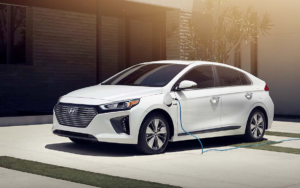Prototype Drive: Hyundai Ioniq Plug-In

While the Hyundai Ioniq hybrid is already on sale nationwide, and the Ioniq Electric is up for grabs in California, the Goldilocks plug-in version doesn’t roll out. Nonetheless, the Hyundai Ioniq Plug-in might be worth the wait; our brief drive of a prototype version near Hyundai’s Michigan-based technical facility left us wondering why the Korean automaker is saving the best for last.
Hyundai’s philosophy behind the Ioniq is that it should drive and feel like a normal car while achieving class-leading fuel efficiency. The thinking is that if you can remove whatever compromises buyers are apprehensive about making by switching to a hybrid, a plug-in, or an EV, the market will come around and consider it like it would any other car.

The key to this strategy is the Ioniq Plug-In’s powertrain, which mirrors that of the standard Ioniq save for its uprated battery and electric motor. For it’s engine, the Plug-In uses the same 1.6-liter I-4 as the regular hybrid, which makes 104-hp and 109 lb-ft of torque. On the electric side, the Ioniq Plug-In makes use of a 44.5-kW electric motor that adds 60 hp and 125 lb-ft of torque for a combined system output of 139 hp. That’s slightly more juice than the Toyota Prius Prime, which maxes out at 121 hp, but less than the Chevrolet Volt, which tops out at 149 hp

In a world with plenty of hybrids to choose from, there’s nothing wild about this engine and electric motor combination. The real differentiator is the Ioniq’s six-speed dual-clutch automatic transmission, which operates more smoothly and seamlessly than the continuously variable transmission in the Prius. While dual-clutches usually have a tendency to be jerky at low speeds, the thrust of the electric motor under acceleration from a stop gives the car enough forward momentum to avoid this entirely.

The 8.9-kWh battery sits low under the rear seats. It’s integrated into the body structure for additional stiffness and beneficially low center of gravity. The Ioniq Plug-In is not a sports car or anything even close to it, but driving around town is perfectly pleasant, especially in all-electric mode. You tend to hear every nasty noise a car makes when it’s as quiet as an EV, so it bodes well for the Ioniq that all we heard was some tire roar from the low rolling resistance Michelin tires. The 16-inch wheels definitely improve the ride as well, as even Michigan’s punishingly rough roads never transmitted anything too jarring into the cabin.
EV range is at least 27 miles, which slightly bests the Prius Prime’s 25 miles but falls well short of the Volt’s 53 miles. Charging takes 2.5 hours on a Level 2 charger. Hyundai claims that this range covers the daily driving needs of a major chunk of American drivers. MPG figures aren’t being released yet, but given that the standard hybrid is rated at 57/59 mpg, the addition of an all-electric function will see even further gains.

Looks-wise, the Ioniq Plug-In isn’t gorgeous (or even remarkable), but it’s certainly easier on the eyes than the Prius Prime. While Toyota went out of its way to make the Prius and Prius Prime look cutting-edge and distinctive, it also created a pair of polarizing designs. The Ioniq’s design is made up of simple, clean lines, with a good-looking but subtle horizontal grille to separate it from the Elantras and Sonatas of the world. Out back is a stubby, aero-friendly rear hatch, with a contrasting black bar between the tapered taillights. Nobody will flock to the Ioniq for its design beauty, but nobody will have great cause to shun it, either.
The story is the same inside, where the Ioniq Plug-In takes a more practical approach to design than the Prius Prime. The Ioniq’s interior feels like any other Hyundai’s, without any crazy deviations to make it seem like a futuristic EV. The Chevy Volt and Toyota Prius Prime take a different strategy, using cues like the Prius’ enormous optional tablet-like center screen and the Volt’s all-digital gauge cluster. With the Ioniq, the focus has clearly been on engineering and practicality. Most notably, the Ioniq Plug-In seats five passengers, while the Volt and Prius Prime only seat four.
Standard equipment is generous. LED daytime running lights, automatic headlights, LED taillights, heated side mirrors, and keyless entry are all included. Dual-zone climate control is included as well, plus heated front seats and a 7-inch center touchscreen that supports both Android Auto and CarPlay. Wireless Qi charging is optional, as is a larger 8-inch touchscreen.
Expect Hyundai to be bullish on pricing, as it has already positioned the $23,035 Ioniq Hybrid to undercut the base Prius by $2,535. The plug-in Prius Prime starts at $27,965, so we wouldn’t be surprise the Ioniq Plug-in to land just north of $25k.
As for the pure-EV Ioniq Electric, it starts at $30,335 before any tax credits, but despite its well-sorted driving dynamics and competitive pricing compared to the $37,495 Bolt, Hyundai is majorly short on range to be seriously in the conversation. Its 124 miles of range pale to the Bolt’s 238 miles, and with the Nissan Leaf on the way to also enter the 200+ mile game, people will be hard-pressed to consider an Ioniq Electric.
“The more value-priced Hyundai Ioniq and Plug-In should do a great job of mainstreaming hybrids for the average buyer,” notes Detroit bureau chief Todd Lassa. “As for the Ioniq Electric, the range difference between it and the Bolt is just too big, even if it’s much cheaper. Anything less than 200 miles is not enough these days.”
It’s likely then, that the best option for hyper milers considering a Korean change of pace is the Hyundai Ioniq Plug-In. Whether it’s a real match for the well established Prius is something the market will tell us, but what is already clear is that Hyundai has put the full thrust of its engineering prowess into developing a new electrified platform that has a real shot at making it onto shopping lists. That is, if gas prices ever go up.




